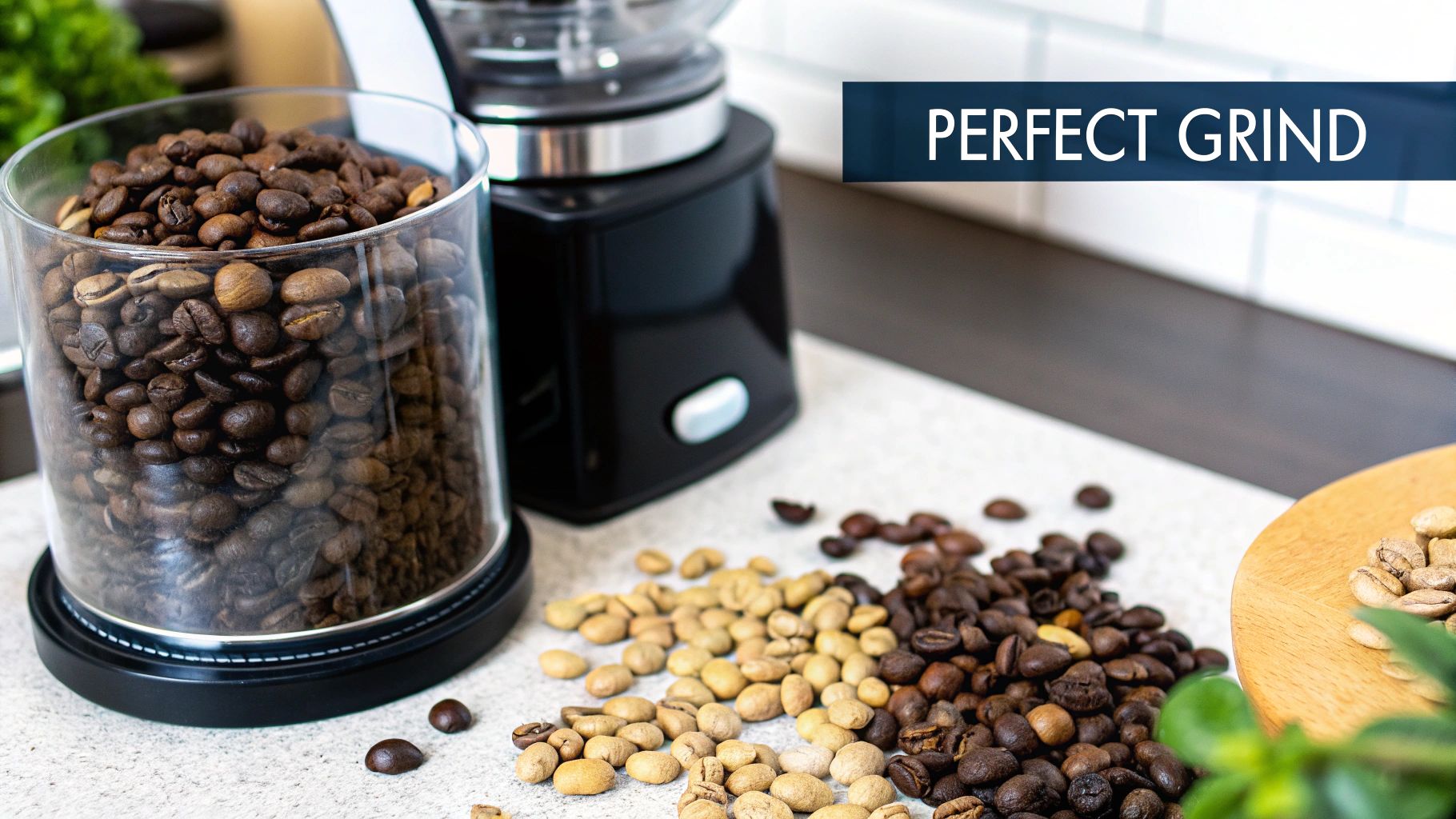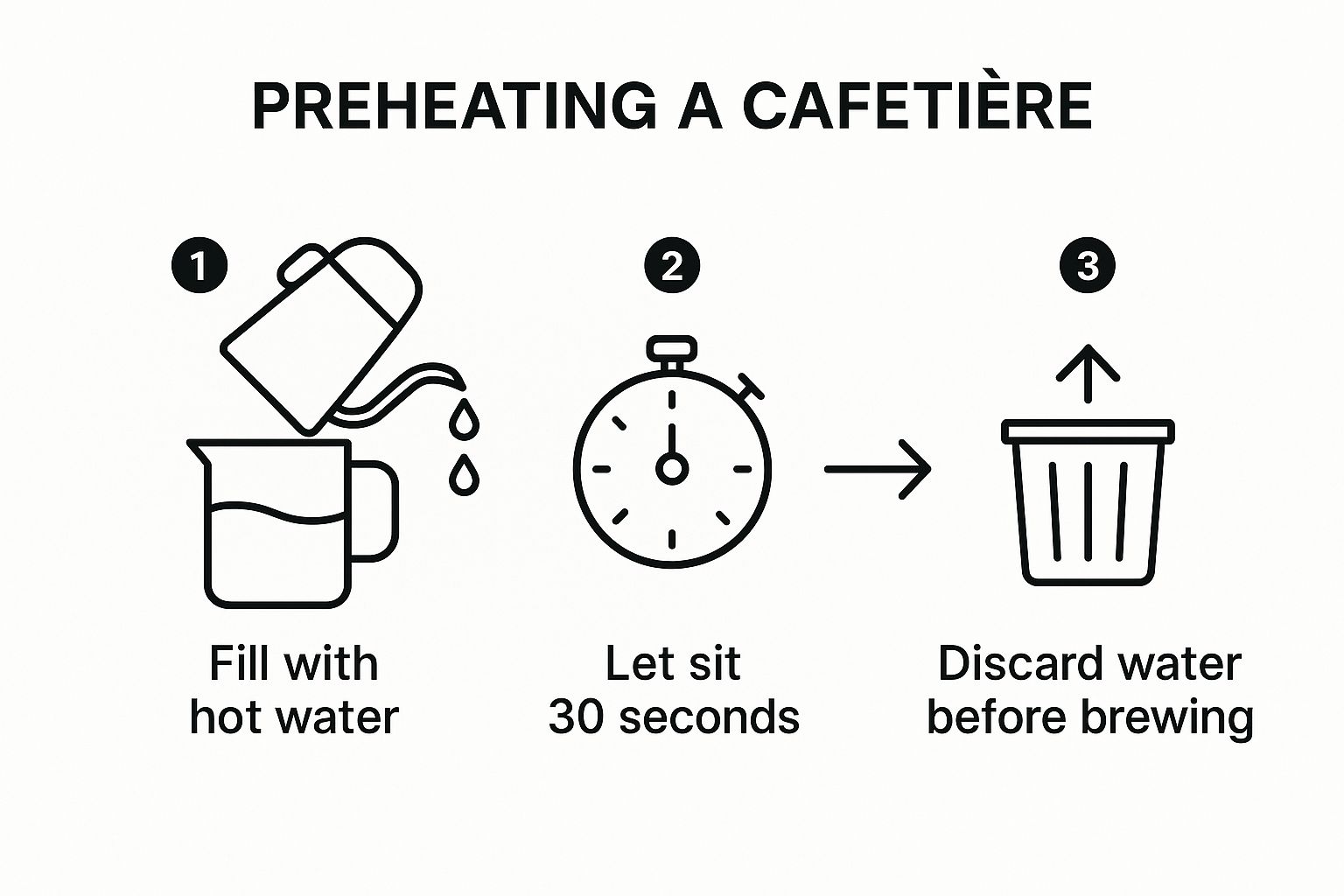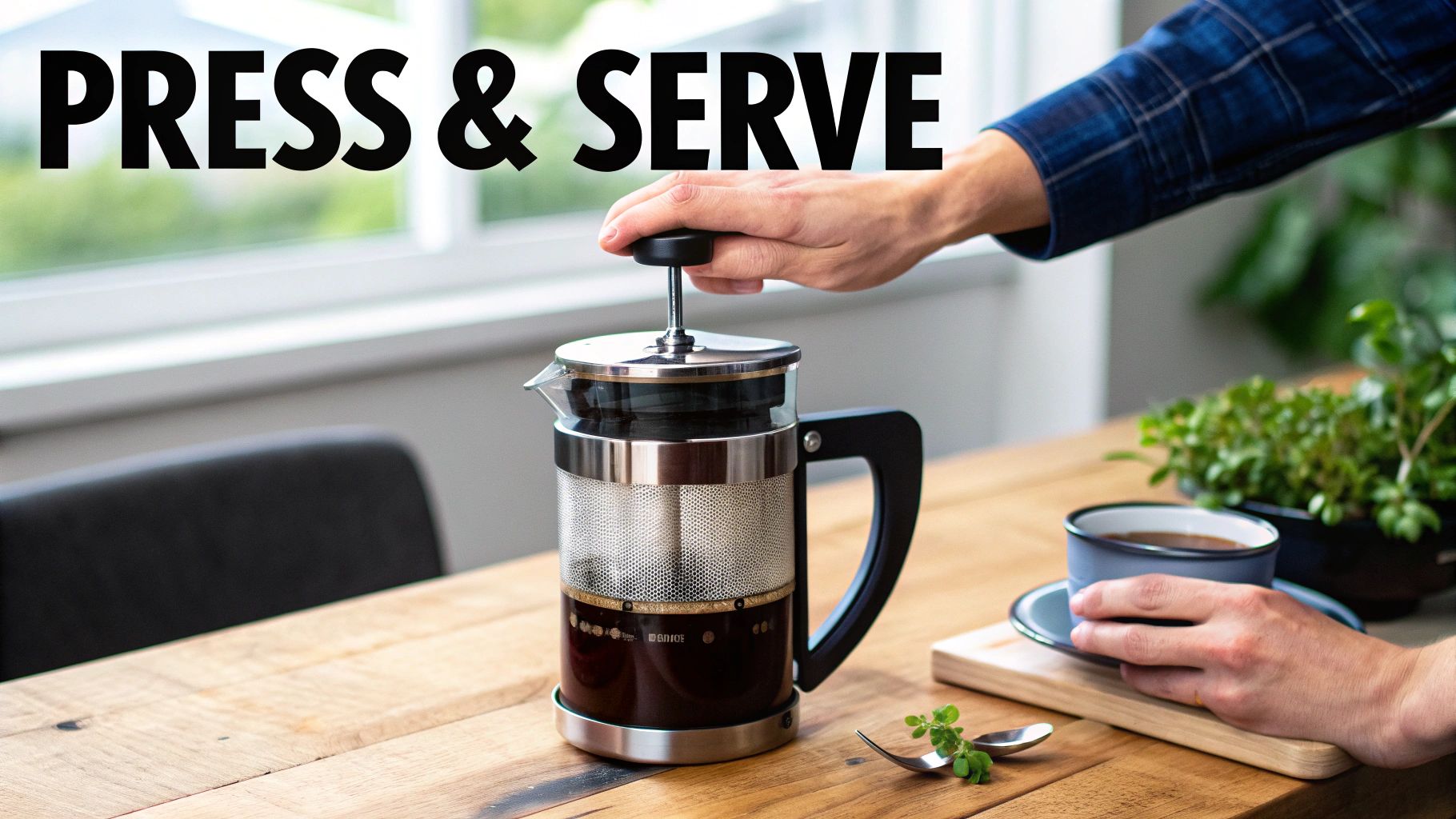
How to Use a Cafetière: A UK Guide to the Perfect Brew
Share
Using a cafetière is a beautifully simple ritual. You add coarsely ground coffee and hot water to the glass jug, let it brew for about four minutes, then slowly press the plunger down to filter the grounds. This immersion method is a classic for a reason, especially here in the UK, and it’s famed for creating a rich, full-bodied cup with very little fuss.
Your Journey to Perfect Cafetière Coffee Starts Here
Think of this as the start of a ritual, one that turns your kitchen into your own personal coffee bar. For so many of us in the UK, the cafetière—or French press, as it's often known—is the key to a truly deep, flavourful brew that a pre-made pod just can't touch. It’s a beautifully hands-on process that connects you to your morning cup in a way that feels just right.
This guide goes beyond the basic instructions you find on the box. We’re diving into the craft and the little details that take a cup of coffee from just 'good' to genuinely memorable. It's about mastering this classic brewing method and turning a simple routine into a moment of pure enjoyment.
We'll be walking through everything that matters:
- How to choose the right coffee beans from the UK's thriving speciality coffee scene.
- Getting the coffee-to-water ratio spot on for a consistent brew every single time.
- Perfecting your steep time and the final plunge for a clean, satisfying cup.
Forget the idea that exceptional coffee is something you can only get in a high-end café. The power to create a flawless brew is already right there in your hands. This is where you start mastering a timeless coffee art.
Assembling Your Essential Brewing Gear

Before you even think about brewing, let's get your kit in order. The quality of your final cup is a direct result of the gear and ingredients you start with, so a little prep here goes a long way.
First up, the cafetière itself. The material makes a difference. A classic glass one is great for watching the magic happen, but an insulated stainless steel model will keep your coffee piping hot for much longer. Size matters, too. If you’re brewing for a crowd, go big. But for a solo cup, a smaller press is better for heat retention and getting the flavour just right.
Choosing Your Coffee and Grind
The heart of any good brew is, of course, the coffee. Sourcing freshly roasted beans from a quality UK roaster will completely change your game. But for a cafetière, the grind is absolutely non-negotiable: it has to be coarse. Think rough sea salt. Anything finer will sneak through the filter, leaving you with a silty, bitter mess.
The most common mistake is using the wrong grind. A proper coarse grind is your single greatest defence against a muddy, disappointing cup of coffee.
The Tools for Precision
While you can technically get by with just a standard kettle, a couple of other tools are what separate a good cup from a great one. ‘Eyeballing’ your measurements is a recipe for inconsistency, and you’ll end up with coffee that’s either disappointingly weak or far too strong.
Here are your secret weapons for a perfect, repeatable brew:
- Digital Scales: You need to weigh your coffee and water. A great starting point is a ratio of around 60 grams of coffee per litre of water.
- A Timer: The four-minute steep is crucial. Leave it too long, and you get over-extraction—the number one cause of bitterness.
This focus on simple, hands-on control is what makes the cafetière so enduringly popular, especially with UK coffee drinkers who love its gadget-free appeal. If you want to dive deeper into UK coffee habits, check out this detailed report.
The Art of the Perfect Cafetière Brew
Alright, let's move from theory to practice. This is where we turn those simple ingredients into a truly exceptional cup of coffee. Forget just going through the motions; brewing with a cafetière is a ritual that, when done right, unlocks the full potential of your beans.
Your first move, and it's a non-negotiable one, is to pre-heat the cafetière. Pouring hot water into a cold glass or steel pot instantly drops the brewing temperature, which is a one-way ticket to a flat, under-extracted coffee. A quick swirl of hot water ensures your brewing environment stays stable from start to finish.
This simple step takes thirty seconds but makes a world of difference.

It’s a small detail, but it’s one of those things that separates a good cup from a great one.
Mastering Ratios And Temperature
Consistency is all about measurement. A great starting point for any coffee lover is a ratio of 60g of coarse ground coffee per litre of water. Think of this as your baseline—a solid foundation you can tweak to find the strength that perfectly suits your taste.
Water temperature is just as crucial. Boiling water (100°C) will scorch the delicate flavour compounds in your coffee, leaving you with a bitter, harsh taste. You're aiming for the sweet spot, somewhere between 90-96°C. The easiest trick? Boil your kettle, then just let it sit for 45-60 seconds before you pour.
The quality of your water also has a massive impact on the final brew. If you're serious about your coffee, it's worth looking into selecting appropriate water filters to really let the beans shine.
Your Quick-Reference Cafetière Ratios
To take the guesswork out of it, here's a handy guide. We're starting with the ideal 1:15 ratio (that's 1g of coffee for every 15ml of water) to get you going.
| Servings (Approx. 200ml) | Coarse Ground Coffee | Hot Water (90-96°C) |
|---|---|---|
| 1 Cup | 13g | 200ml |
| 2 Cups | 26g | 400ml |
| 3 Cups | 40g | 600ml |
| 4 Cups | 53g | 800ml |
Feel free to adjust these numbers up or down a gram or two once you get a feel for what you like.
The Bloom, The Steep, And The Plunge
With your coffee grounds in the pre-heated cafetière, pour just enough hot water to completely saturate them—about double the weight of the coffee itself. This is the bloom. You'll see the grounds bubble up as trapped CO2 escapes. Let this happen for about 30 seconds; it's a vital step for an even, flavourful extraction.
After the bloom, pour in the rest of your water, pop the lid on, and start a timer for four minutes. This is where the magic happens. During this steep, the water is busy drawing out all the rich character and complexity from the coffee.
Once those four minutes are up, resist the temptation to slam the plunger down. A slow, steady press is key. Pushing too hard stirs up the fine particles at the bottom, which is what gives you a muddy, gritty cup. A gentle plunge keeps the brew clean and smooth, delivering that perfect, sediment-free finish we're all after.
Nailing Your Technique: How to Avoid Common Cafetière Mistakes
Ever brew a cafetière and wonder why the coffee tastes muddy, bitter, or just disappointingly weak? You’re not alone. Let’s walk through the most common pitfalls that stand between you and a perfect brew, turning that morning cup from just 'okay' to genuinely brilliant.
The number one complaint is about a silty, gritty texture. This almost always comes down to two things: a coffee grind that’s too fine, and a plunge that’s far too aggressive.
For a cafetière, you want your coffee grounds to resemble coarse sea salt. If they’re any finer, they’ll slip right through the mesh filter and create that unpleasant sludge at the bottom of your mug. This is non-negotiable for a clean cup.
Then comes the plunge. Think of it as gently guiding the filter to the bottom, not forcing it. Pushing down too hard or too fast just churns up the settled grounds and forces those fine particles straight through the filter. A slow, steady plunge is your best friend here.
What Your Coffee’s Flavour Is Telling You
The final taste of your coffee tells a story about its extraction. Getting this right is the real secret to mastering the cafetière. It all comes down to a simple balance:
- Over-extracted coffee tastes bitter and harsh. This is what happens when you let it brew for too long—usually beyond five minutes—which pulls out all sorts of undesirable compounds from the grounds.
- Under-extracted coffee tastes sour or unpleasantly acidic. This is the result of a brew time that's too short, so you haven't given the water enough time to draw out the coffee’s natural sweetness and depth. That four-minute steep is your sweet spot for a reason.
Here's the most critical tip: never leave your coffee in the cafetière after plunging. The grounds don't just stop brewing; they keep on extracting, turning a perfectly balanced cup into a bitter mess within minutes. Always decant the entire brew straight away into mugs or a separate thermal server.
The Unseen Influence of UK Water
Something that often gets overlooked, especially across much of the UK, is our hard water. The high mineral content—particularly calcium and magnesium—can completely mute the delicate, bright notes of a speciality coffee, leading to a dull, flat-tasting cup.
You don't need to become a water chemist, but using a simple charcoal water filter jug can make a world of difference. It softens the water just enough to let the unique flavour profile of your beans shine through. It’s a small, easy change that delivers a much cleaner and more enjoyable brew.
Elevating Your Brew Beyond the Basics

Once you’ve got the fundamentals down, the real fun begins. This is where you can start tweaking your process to pull something truly special out of your cafetière, moving beyond the standard four-minute brew.
One popular advanced technique rethinks the standard approach by extending the brew time and adding a couple of clever steps. The goal? To produce an incredibly clean, sediment-free cup that still has all the body and richness a cafetière is known for.
A Cleaner Cup with This Advanced Method
This refined approach is perfect for a weekend morning when you have a bit more time to savour the ritual. It takes a little patience, but the results are well worth it.
- Brew for Four Minutes: Start things off as you normally would. Pour your hot water over the coarse grounds and let everything steep for four minutes.
- Break the Crust: Once the timer goes, you’ll see a crust of coffee grounds floating on top. Gently stir this layer to let the grounds sink. Then, grab two spoons and skim off any remaining foam or floaters from the surface.
- Wait Patiently: Here’s the game-changing part. Don’t plunge yet. Instead, just let the coffee sit for another five to eight minutes. This extra time allows all the fine particles to settle at the bottom on their own.
- Plunge Gently: Finally, press the plunger down, but only until it’s just below the surface of the coffee. Think of it as a final filter, not a press. Pour slowly and carefully to avoid stirring up that sediment at the bottom.
This longer, more patient method might seem counterintuitive, but it produces a remarkably clean cup. You get all the full-bodied richness you love from a cafetière, but without any of the grit.
Pairing Roasts with Your Technique
Experimenting with different roasts from UK speciality roasters is another fantastic way to elevate your brew. A light-roast, single-origin Ethiopian bean, for example, will have bright, fruity notes that a longer steep might overpower. On the other hand, a dark, chocolatey blend from South America can really stand up to a more robust extraction.
It’s all about adjusting your technique to highlight what makes each coffee unique.
Beyond just the flavour, the hands-on nature of manual brewing has really struck a chord with environmentally conscious coffee drinkers. The cafetière doesn't need electricity and only uses coffee and water, which means far less waste compared to single-use pods. This focus on both quality and consciousness is a huge part of the UK’s speciality coffee scene. You can explore more about UK coffee consumption trends to see just how much sustainability is shaping our habits.
Your Cafetière Questions Answered

As you get to grips with your cafetière, a few common questions always seem to pop up. Nailing these little details is what separates a decent brew from a truly great one, and it’s the key to mastering this classic brewing method.
What Is the Best Grind Size for a Cafetière?
For a cafetière, you need a coarse grind. Think of something with the texture of rough sea salt. If your coffee is ground too finely, the tiny particles will slip straight through the mesh filter, creating a muddy, sludgy texture in your cup and likely clogging the plunger.
When you're buying pre-ground coffee, always look for bags specifically labelled for cafetière or French press use. This simple step ensures a clean press and a much clearer, more enjoyable brew every time.
Using the correct grind is the single most important factor in avoiding a silty cup. It provides the foundation for a clean, full-bodied extraction that lets the coffee's true flavour shine through.
How Should I Clean My Cafetière Properly?
Good cleaning habits are non-negotiable for fresh-tasting coffee. After you’ve enjoyed your brew, scoop the used grounds into your food waste or compost bin. Never be tempted to wash them down the sink, as this is a sure-fire way to cause serious blockages.
Give the carafe and plunger a good rinse with warm water. For a deeper clean, it's worth occasionally disassembling the filter mechanism and washing all the parts in warm, soapy water. This gets rid of any built-up coffee oils, which can turn rancid over time and spoil the flavour of your future brews.
Can I Make Just One Cup in a Large Cafetière?
You can, but it’s not recommended if you’re chasing the best flavour. The biggest problem is heat loss. A small amount of water in a large glass or steel carafe cools down far too quickly, and this rapid temperature drop leads to under-extraction. The result? A coffee that tastes weak, thin, and a bit sour.
If you regularly find yourself brewing for one, investing in a smaller 1-cup or 3-cup model is a worthwhile move. It will give you far more consistent and delicious results day in, day out.
Ready to brew your perfect cup? At Ue Coffee Roasters, we source and roast exceptional beans ideal for your cafetière. Explore our curated selection of blends and single origins to elevate your home coffee experience. Find your new favourite coffee today.
